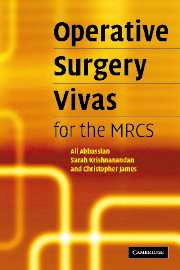Book contents
- Frontmatter
- Contents
- Preface
- 1 The elective repair of an abdominal aortic aneurysm
- 2 Adrenalectomy
- 3 Amputation (below knee)
- 4 Anorectal abscesses, fistulae and pilonidal sinus
- 5 Appendicectomy
- 6 Principles of bowel anastomosis
- 7 Breast surgery
- 8 Carotid endarterectomy
- 9 Carpal tunnel decompression
- 10 Central venous cannulation
- 11 Cholecystectomy (laparoscopic)
- 12 Circumcision
- 13 Colles' fracture (closed reduction of)
- 14 Compound fractures
- 15 Dupuytren's contracture release
- 16 Dynamic hip screw
- 17 Fasciotomy for compartment syndrome
- 18 Femoral embolectomy
- 19 Femoral hernia repair
- 20 Haemorrhoidectomy
- 21 Hip surgery
- 22 Hydrocele repair
- 23 The open repair of an inguinal hernia
- 24 Laparotomy and abdominal incisions
- 25 Oesophago-gastroduodenoscopy
- 26 Orchidectomy
- 27 Parotidectomy
- 28 Perforated peptic ulcer
- 29 Pyloric stenosis and Ramstedt's pyloromyotomy
- 30 Right hemicolectomy
- 31 Skin cover (the reconstructive ladder)
- 32 Spinal procedures
- 33 Splenectomy
- 34 Stomas
- 35 Submandibular gland excision
- 36 Tendon repairs
- 37 Thoracostomy (insertion of a chest drain)
- 38 Thoracotomy
- 39 Thyroidectomy
- 40 Tracheostomy
- 41 Urinary retention and related surgical procedures
- 42 Varicose vein surgery
- 43 Vasectomy
- 44 Zadik's procedure
25 - Oesophago-gastroduodenoscopy
Published online by Cambridge University Press: 16 October 2009
- Frontmatter
- Contents
- Preface
- 1 The elective repair of an abdominal aortic aneurysm
- 2 Adrenalectomy
- 3 Amputation (below knee)
- 4 Anorectal abscesses, fistulae and pilonidal sinus
- 5 Appendicectomy
- 6 Principles of bowel anastomosis
- 7 Breast surgery
- 8 Carotid endarterectomy
- 9 Carpal tunnel decompression
- 10 Central venous cannulation
- 11 Cholecystectomy (laparoscopic)
- 12 Circumcision
- 13 Colles' fracture (closed reduction of)
- 14 Compound fractures
- 15 Dupuytren's contracture release
- 16 Dynamic hip screw
- 17 Fasciotomy for compartment syndrome
- 18 Femoral embolectomy
- 19 Femoral hernia repair
- 20 Haemorrhoidectomy
- 21 Hip surgery
- 22 Hydrocele repair
- 23 The open repair of an inguinal hernia
- 24 Laparotomy and abdominal incisions
- 25 Oesophago-gastroduodenoscopy
- 26 Orchidectomy
- 27 Parotidectomy
- 28 Perforated peptic ulcer
- 29 Pyloric stenosis and Ramstedt's pyloromyotomy
- 30 Right hemicolectomy
- 31 Skin cover (the reconstructive ladder)
- 32 Spinal procedures
- 33 Splenectomy
- 34 Stomas
- 35 Submandibular gland excision
- 36 Tendon repairs
- 37 Thoracostomy (insertion of a chest drain)
- 38 Thoracotomy
- 39 Thyroidectomy
- 40 Tracheostomy
- 41 Urinary retention and related surgical procedures
- 42 Varicose vein surgery
- 43 Vasectomy
- 44 Zadik's procedure
Summary
Describe the important anatomical narrowings of the oesophagus
The oesophagus is a muscular tube approximately 25 cm long from the pharynx to the stomach. There are four anatomical narrowings to the oesophagus, these are listed proximal to distally. They may be visualised on oesophago-gastroduodenoscopy (OGD) and are also the regions where foreign bodies may lodge and perforation are most likely to occur:
Cricopharyngeal muscle
Aortic arch
Left main bronchus
Lower oesophageal sphincter
What is an OGD and what are the advantages compared to contrast imaging?
OGD is the passage through the upper gastrointestinal (GI) tract using a flexible steerable fibre-optic telescope, which allows for direct visualisation of the tissues. The advantage over radiology is that a direct visualisation is achieved, early malignancies are detected (biopsy), exact identification of bleeding ulcers is achieved and therapy may be instituted.
What other therapies may be achieved during an OGD?
Treatment of oesophageal strictures with dilatation techniques. The endoscope is passed into the oesophagus, the stricture is visualised and a wire passed through the stricture. The endoscope is then removed and increasing sized plastic dilators passed over the wire through the stricture until satisfactory clearance is achieved.
Duodenoscopy allows for treatment of biliary tract disease.
Percutaneous endoscopic gastrostomy (PEG) tube insertion.
4 Describe the steps undertaken in performing an OGD for a bleeding peptic ulcer
It must be first decided if the bleed is a low risk or high risk (e.g. Rockwall scoring system). If high-risk then an urgent OGD must be performed, if low-risk group the OGD should be done within 24 hours.
- Type
- Chapter
- Information
- Operative Surgery Vivas for the MRCS , pp. 93 - 96Publisher: Cambridge University PressPrint publication year: 2006



